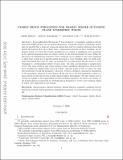Stable Shock Formation for Nearly Simple Outgoing Plane Symmetric Waves
Author(s)
Speck, Jared; Holzegel, Gustav; Luk, Jonathan; Wong, Willie
DownloadAccepted version (2.701Mb)
Open Access Policy
Open Access Policy
Creative Commons Attribution-Noncommercial-Share Alike
Terms of use
Metadata
Show full item recordAbstract
© 2016, Springer International Publishing AG. In an influential 1964 article, P. Lax studied 2 × 2 genuinely nonlinear strictly hyperbolic PDE systems (in one spatial dimension). Using the method of Riemann invariants, he showed that a large set of smooth initial data lead to bounded solutions whose first spatial derivatives blow up in finite time, a phenomenon known as wave breaking. In the present article, we study the Cauchy problem for two classes of quasilinear wave equations in two spatial dimensions that are closely related to the systems studied by Lax. When the data have one-dimensional symmetry, Lax’s methods can be applied to the wave equations to show that a large set of smooth initial data lead to wave breaking. Here we study solutions with initial data that are close, as measured by an appropriate Sobolev norm, to data belonging to a distinguished subset of Lax’s data: the data corresponding to simple plane waves. Our main result is that under suitable relative smallness assumptions, the Lax-type wave breaking for simple plane waves is stable. The key point is that we allow the data perturbations to break the symmetry. Moreover, we give a detailed, constructive description of the asymptotic behavior of the solution all the way up to the first singularity, which is a shock driven by the intersection of null (characteristic) hyperplanes. We also outline how to extend our results to the compressible irrotational Euler equations. To derive our results, we use Christodoulou’s framework for studying shock formation to treat a new solution regime in which wave dispersion is not present.
Date issued
2016Department
Massachusetts Institute of Technology. Department of MathematicsJournal
Annals of PDE [21992576]
Publisher
Springer Science and Business Media LLC